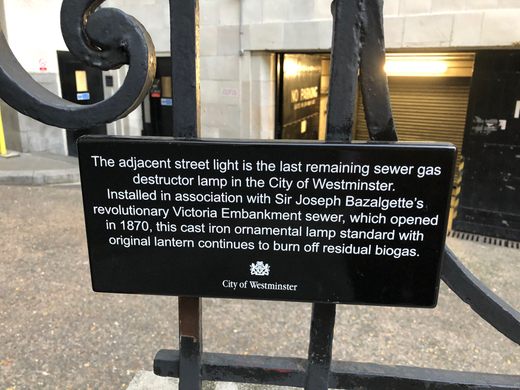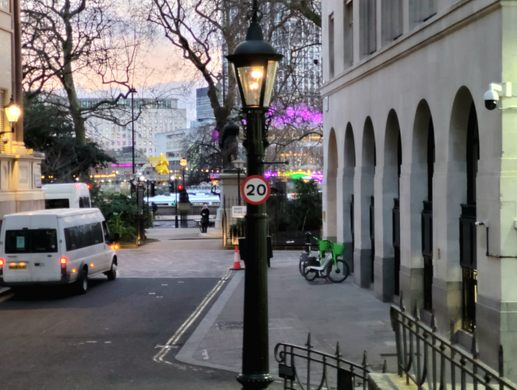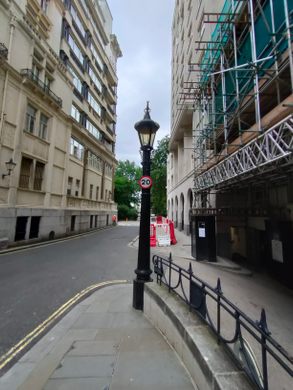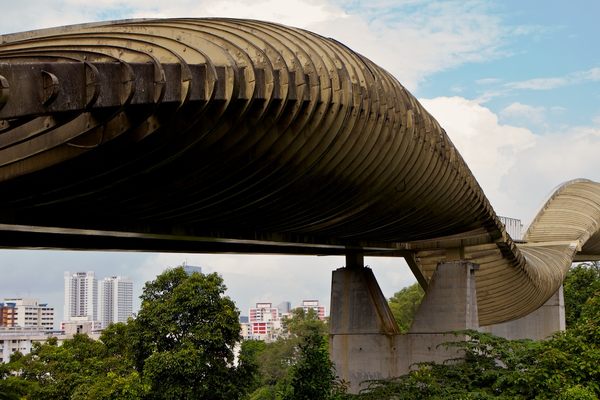Carting Lane Sewer Lamp
The pretty iron lamp is a reminder of the architecture underneath London's streets.
Just off one of London’s bustling streets, there’s a special streetlight that signposts the warren of waste pipes winding beneath the city.
By the end of the 19th century, London was trying to shed its reputation as a stinky cesspool. For years, locals had slogged through streets strewn with human waste. Now, it had an expansive sewer network that shuttled these excretions around. Trouble was, that matrix was smelly, too—and full of gas. Engineers proposed various ideas for ventilating the sewers, and one of those schemes included lamps that would burn off the gases from the underground world while illuminating the streets above.
Patented by British engineer Joseph Edmund Webb in the 1890s, the so-called “sewer gas destructor lamps” were designed to extract gases from the pipes and burn them off at high heat. (An 1896 notice in The Standard newspaper boasted that the lamps worked by an extractor pipe that “communicates with the sewer and conveys the sewer gas direct to the lamp, where it is subjected to a temperature of 650 degrees to 750 degrees Fahrenheit, thus cremating all the germs and nauseous gases and producing more perfect combustion, whereby the light is much increased.”) This didn’t always work especially well, and revised versions relied on a town’s gas mains, too, to keep a flame perpetually flickering while still also drawing methane from the sewer.
Soon, the lamps lined streets in several cities, in England and beyond. A local official from Winnipeg, Canada, returned home from a visit to London in 1907 convinced that his hometown should install some sewer lamps of its own. (The city had already pledged $2,000 to the cause of exterminating foul sewer smells, the Manitoba Morning Free Press reported at the time, and at a cost of $100 apiece—and with a supposed track record of success—the lamps seemed like good bang for the buck.)
Most of these lamps are now gone, but you can still find one just off the Strand, not far from Trafalgar Square and Covent Garden. Duck off the Strand and onto Carting Lane, on the west side of the Savoy Theatre and hotel, and descend the steps next to the Coal Hole pub, where you’ll likely find crowds queuing for fish and chips. Continue down the narrow street, past goods being unloaded for the hotel or employees popping out for a quick smoke, and head toward the water. You’ll find the dark-colored, elegantly decorated lamp on the right-hand side, near a fence-mounted plaque that identifies it as “the last remaining sewer gas lamp in the City of Westminster.”
Writing in his book The London Nobody Knows, in 1962, British artist and author Geoffrey Fletcher described the hollow iron lamp as a “superb specimen, richly topped with ornament,” and observed that foul smells still occasionally drifted through the air nearby—though these were no “more noxious than cabbage water and the odor of London dinners.” Even so, some locals apparently still refer to Carting Lane as “Farting Lane” in an affectionate jab at its past.
This lonely lamp doesn’t look quite as it once did—some reports say it was restored after a run-in with a truck, and others suggest it’s more accurate to describe the lamp as a functional replica. Either way, it’s a reference to the rank, not-so-distant past, and, as the London Metropolitan Archives describes it in the exhibition Underground London, “a street-level reminder of what lies beneath.”
Know Before You Go
The lamp burns all day and night. For the most striking effect, visit after dark—and while you're there, pop into the nearby Savoy Hotel and check out their little museum, which features photos, old liquors, and a 1969 thank-you note from Neil Armstrong on NASA stationery, thanking the staff for sending champagne and cocktail glasses to toast the moon landing.
Unfortunately you can't stop progress, and any historical setting of the lamp has been ruined by the speed limit sign that has been attached to it.


























Follow us on Twitter to get the latest on the world's hidden wonders.
Like us on Facebook to get the latest on the world's hidden wonders.
Follow us on Twitter Like us on Facebook